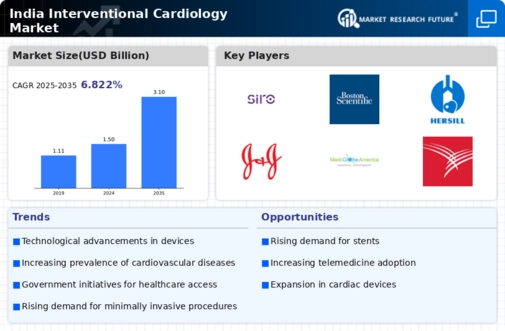Increasing Aging Population
The demographic shift towards an aging population in India is a crucial driver for the interventional cardiology market. As individuals age, the prevalence of cardiovascular diseases tends to rise, necessitating advanced interventional procedures. By 2025, it is projected that over 140 million people in India will be aged 60 and above, significantly increasing the demand for interventional cardiology services. This demographic trend indicates a growing need for innovative treatment options, including angioplasty and stenting, which are essential in managing heart conditions. The interventional cardiology market is likely to expand as healthcare providers adapt to the needs of this aging population, ensuring that they have access to the latest technologies and treatments.
Rising Healthcare Expenditure
India's increasing healthcare expenditure is another significant driver for the interventional cardiology market. With the government and private sectors investing more in healthcare infrastructure, the availability of advanced medical technologies is improving. In recent years, healthcare spending has risen to approximately 3.5% of GDP, reflecting a commitment to enhancing healthcare services. This financial commitment allows for the procurement of state-of-the-art interventional cardiology equipment and training for healthcare professionals. As hospitals upgrade their facilities and expand their cardiology departments, the interventional cardiology market is expected to witness substantial growth, catering to the rising demand for effective cardiovascular treatments.
Growing Awareness of Heart Health
There is a notable increase in awareness regarding heart health among the Indian population, which serves as a vital driver for the interventional cardiology market. Public health campaigns and educational initiatives have contributed to a better understanding of cardiovascular diseases and the importance of early intervention. As individuals become more informed about risk factors and treatment options, they are more likely to seek medical assistance for heart-related issues. This heightened awareness is likely to lead to an increase in diagnostic procedures and interventional treatments, thereby propelling the growth of the interventional cardiology market. The focus on preventive care and early detection is expected to shape the future landscape of cardiovascular healthcare in India.
Supportive Regulatory Environment
A supportive regulatory environment is fostering growth in the interventional cardiology market. The Indian government has implemented policies aimed at streamlining the approval process for medical devices and treatments, which encourages innovation and investment in the healthcare sector. Regulatory bodies are increasingly focusing on ensuring the safety and efficacy of interventional cardiology products, which enhances market confidence. This proactive approach is likely to attract both domestic and international players to invest in the Indian market, further driving competition and technological advancements. As a result, the interventional cardiology market is expected to benefit from a wider range of products and services, ultimately improving patient outcomes.
Technological Innovations in Cardiac Devices
Technological innovations in cardiac devices are transforming the interventional cardiology market in India. The introduction of minimally invasive techniques and advanced imaging technologies has revolutionized the way cardiovascular diseases are treated. Devices such as drug-eluting stents and bioresorbable scaffolds are gaining traction, offering improved outcomes for patients. The market for these advanced devices is projected to grow at a CAGR of around 12% over the next few years. As healthcare providers adopt these innovations, the interventional cardiology market is likely to expand, providing patients with more effective and less invasive treatment options. This trend indicates a shift towards personalized medicine, where treatments are tailored to individual patient needs.

















Leave a Comment